系统功能语言学概论 胡壮麟 张德禄 李战子
- 格式:doc
- 大小:28.50 KB
- 文档页数:2
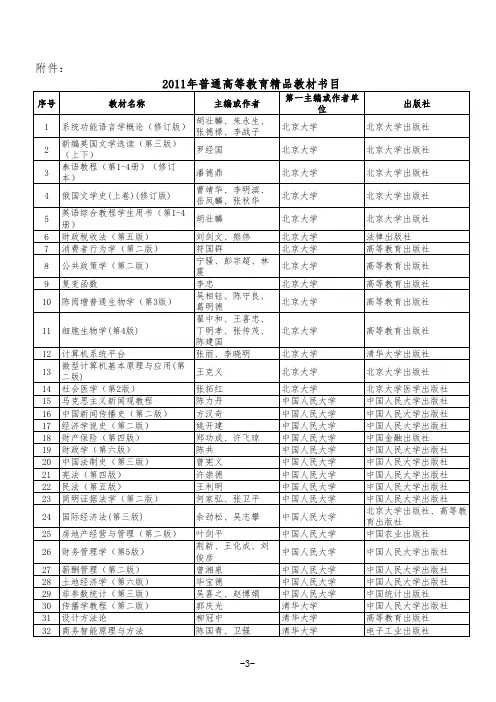
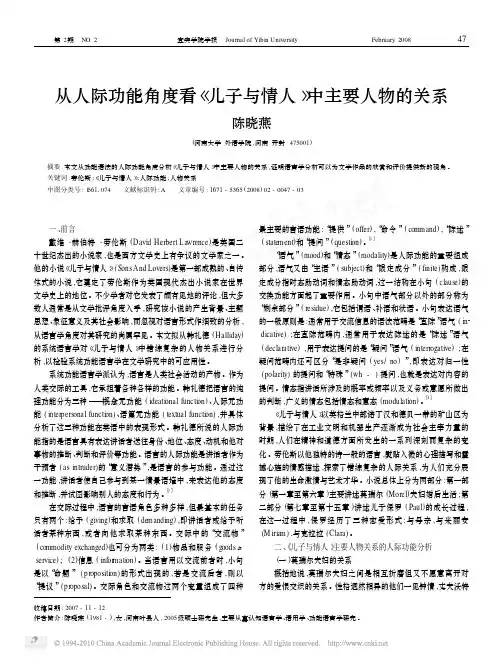
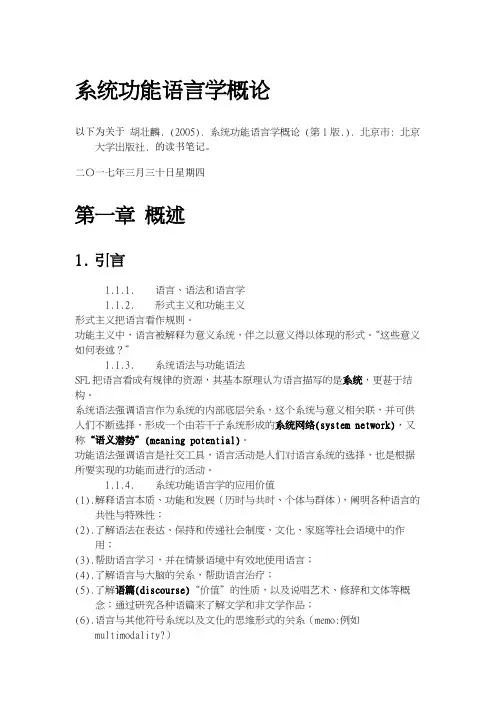
系统功能语言学概论以下为关于胡壮麟. (2005). 系统功能语言学概论 (第1版.). 北京市: 北京大学出版社. 的读书笔记。
二〇一七年三月三十日星期四第一章概述1.引言1.1.1.语言、语法和语言学1.1.2.形式主义和功能主义形式主义把语言看作规则。
功能主义中,语言被解释为意义系统,伴之以意义得以体现的形式。
“这些意义如何表述?”1.1.3.系统语法与功能语法SFL把语言看成有规律的资源,其基本原理认为语言描写的是系统,更甚于结构。
系统语法强调语言作为系统的内部底层关系,这个系统与意义相关联,并可供人们不断选择,形成一个由若干子系统形成的系统网络(system network),又称“语义潜势”(meaning potential)。
功能语法强调语言是社交工具,语言活动是人们对语言系统的选择,也是根据所要实现的功能而进行的活动。
1.1.4.系统功能语言学的应用价值(1).解释语言本质、功能和发展(历时与共时、个体与群体),阐明各种语言的共性与特殊性;(2).了解语法在表达、保持和传递社会制度、文化、家庭等社会语境中的作用;(3).帮助语言学习,并在情景语境中有效地使用语言;(4).了解语言与大脑的关系,帮助语言治疗;(5).了解语篇(discourse)“价值”的性质,以及说唱艺术、修辞和文体等概念;通过研究各种语篇来了解文学和非文学作品;(6).语言与其他符号系统以及文化的思维形式的关系(memo:例如multimodality?)(7).等等。
1.1.5.系统功能语言学派1.2.韩礼德的语言学史观1.2.1.古希腊时期的两种语言观念1.2.2.中世纪和20世纪前的两种语言观念随着资本主义在18世纪的向外扩张,具有人类学倾向的语言观念逐渐抬头,语言学家开始重视研究欧洲俗语以及美亚非各地语言。
1.2.3.近代的两种语言观念一些学科,如心理学、社会学,与语言学的研究都有关,但这些学科只是把语言作为进行本学科研究的工具,正如语言学把心理学、社会学作为研究语言的工具(而非对象)一样,看问题的角度各不相同。

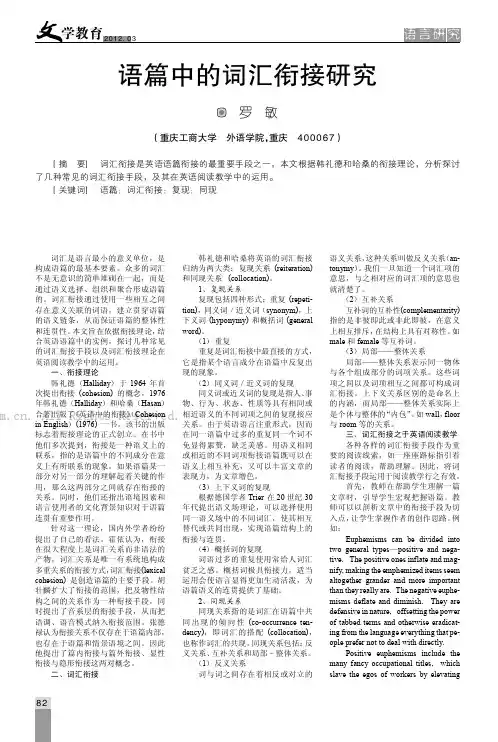
2012.03学教育82语篇中的词汇衔接研究罗敏(重庆工商大学外语学院,重庆400067)[摘要]词汇衔接是英语语篇衔接的最重要手段之一,本文根据韩礼德和哈桑的衔接理论,分析探讨了几种常见的词汇衔接手段,及其在英语阅读教学中的运用。
[关键词]语篇;词汇衔接;复现;同现词汇是语言最小的意义单位,是构成语篇的最基本要素。
众多的词汇不是无意识的简单堆砌在一起,而是通过语义选择、组织和聚合形成语篇的。
词汇衔接通过使用一些相互之间存在意义关联的词语,建立贯穿语篇的语义链条,从而保证语篇的整体性和连贯性。
本文旨在依据衔接理论,结合英语语篇中的实例,探讨几种常见的词汇衔接手段以及词汇衔接理论在英语阅读教学中的运用。
一、衔接理论韩礼德(Halliday )于1964年首次提出衔接(cohesion )的概念,1976年韩礼德(Halliday )和哈桑(Hasan )合著出版了《英语中的衔接》(Cohesion in English )(1976)一书。
该书的出版标志着衔接理论的正式创立。
在书中他们多次提到,衔接是一种语义上的联系,指的是语篇中的不同成分在意义上有所联系的现象。
如果语篇某一部分对另一部分的理解起着关键的作用,那么这两部分之间就存在衔接的关系。
同时,他们还指出语境因素和语言使用者的文化背景知识对于语篇连贯有重要作用。
针对这一理论,国内外学者纷纷提出了自己的看法。
霍依认为,衔接在很大程度上是词汇关系而非语法的产物,词汇关系是唯一有系统地构成多重关系的衔接方式,词汇衔接(lexical cohesion )是创造语篇的主要手段。
胡壮麟扩大了衔接的范围,把及物性结构之间的关系作为一种衔接手段,同时提出了音系层的衔接手段,从而把语调、语音模式纳入衔接范围。
张德禄认为衔接关系不仅存在于语篇内部,也存在于语篇和情景语境之间。
因此他提出了篇内衔接与篇外衔接、显性衔接与隐形衔接这两对概念。
二、词汇衔接韩礼德和哈桑将英语的词汇衔接归纳为两大类:复现关系(reiteration )和同现关系(collocation )。
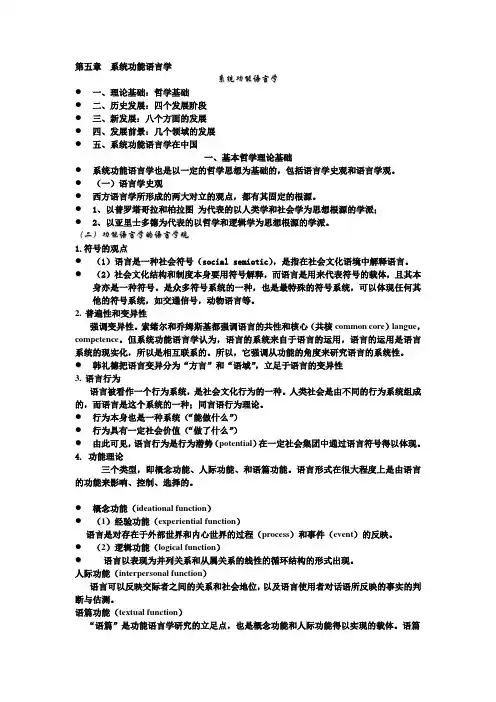
第五章系统功能语言学系统功能语言学●一、理论基础:哲学基础●二、历史发展:四个发展阶段●三、新发展:八个方面的发展●四、发展前景:几个领域的发展●五、系统功能语言学在中国一、基本哲学理论基础●系统功能语言学也是以一定的哲学思想为基础的,包括语言学史观和语言学观。
●(一)语言学史观●西方语言学所形成的两大对立的观点,都有其固定的根源。
●1、以普罗塔哥拉和柏拉图为代表的以人类学和社会学为思想根源的学派;●2、以亚里士多德为代表的以哲学和逻辑学为思想根源的学派。
(二)功能语言学的语言学观1.符号的观点●(1)语言是一种社会符号(social semiotic),是指在社会文化语境中解释语言。
●(2)社会文化结构和制度本身要用符号解释,而语言是用来代表符号的载体,且其本身亦是一种符号。
是众多符号系统的一种,也是最特殊的符号系统,可以体现任何其他的符号系统,如交通信号,动物语言等。
2. 普遍性和变异性强调变异性。
索绪尔和乔姆斯基都强调语言的共性和核心(共核common core)langue,competence。
但系统功能语言学认为,语言的系统来自于语言的运用,语言的运用是语言系统的现实化,所以是相互联系的。
所以,它强调从功能的角度来研究语言的系统性。
●韩礼德把语言变异分为“方言”和“语域”,立足于语言的变异性3. 语言行为语言被看作一个行为系统,是社会文化行为的一种。
人类社会是由不同的行为系统组成的,而语言是这个系统的一种;同言语行为理论。
●行为本身也是一种系统(“能做什么”)●行为具有一定社会价值(“做了什么”)●由此可见,语言行为是行为潜势(potential)在一定社会集团中通过语言符号得以体现。
4. 功能理论三个类型,即概念功能、人际功能、和语篇功能。
语言形式在很大程度上是由语言的功能来影响、控制、选择的。
●概念功能(ideational function)●(1)经验功能(experiential function)语言是对存在于外部世界和内心世界的过程(process)和事件(event)的反映。
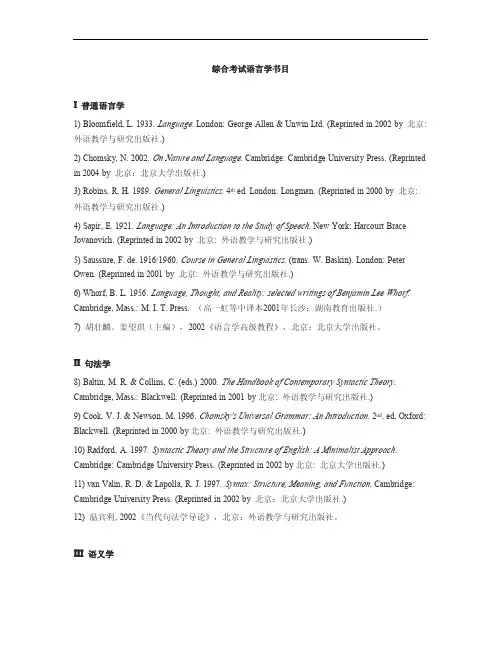
综合考试语言学书目I普通语言学1)Bloomfield,nguage.London:George Allen&Unwin Ltd.(Reprinted in2002by北京:外语教学与研究出版社.)2)Chomsky,N.2002.On Nature and Language.Cambridge:Cambridge University Press.(Reprinted in2004by北京:北京大学出版社.)3)Robins,R.H.1989.General Linguistics.4th ed.London:Longman.(Reprinted in2000by北京:外语教学与研究出版社.)4)Sapir,nguage:An Introduction to the Study of Speech.New York:Harcourt Brace Jovanovich.(Reprinted in2002by北京:外语教学与研究出版社.)5)Saussure,F.de.1916/1960.Course in General Linguistics.(trans.W.Baskin).London:Peter Owen.(Reprinted in2001by北京:外语教学与研究出版社.)6)Whorf,nguage,Thought,and Reality:selected writings of Benjamin Lee Whorf. Cambridge,Mass.:M.I.T.Press.(高一虹等中译本2001年长沙:湖南教育出版社.)7)胡壮麟、姜望琪(主编),2002《语言学高级教程》,北京:北京大学出版社。
II句法学8)Baltin,M.R.&Collins,C.(eds.)2000.The Handbook of Contemporary Syntactic Theory. Cambridge,Mass.:Blackwell.(Reprinted in2001by北京:外语教学与研究出版社.)9)Cook,V.J.&Newson,M.1996.Chomsky's Universal Grammar:An Introduction.2nd.ed.Oxford: Blackwell.(Reprinted in2000by北京:外语教学与研究出版社.)10)Radford,A.1997.Syntactic Theory and the Structure of English:A Minimalist Approach. Cambridge:Cambridge University Press.(Reprinted in2002by北京:北京大学出版社.)11)van Valin,R.D.&Lapolla,R.J.1997.Syntax:Structure,Meaning,and Function.Cambridge: Cambridge University Press.(Reprinted in2002by北京:北京大学出版社.)12)温宾利,2002《当代句法学导论》,北京:外语教学与研究出版社。
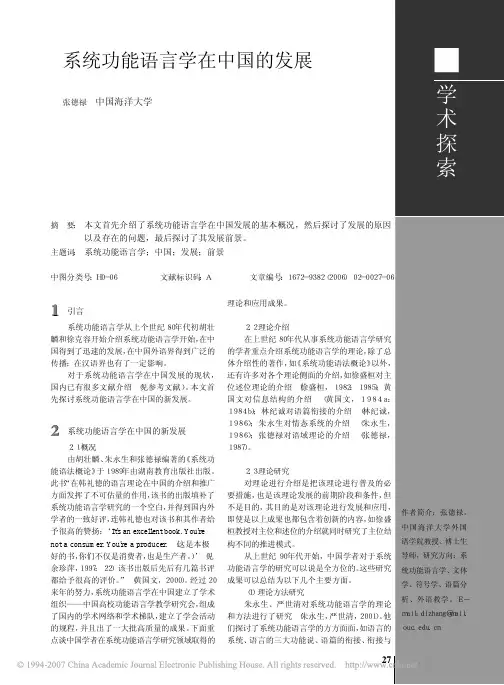
200621系统功能语言学在中国的发展张德禄 中国海洋大学摘 要:本文首先介绍了系统功能语言学在中国发展的基本概况,然后探讨了发展的原因以及存在的问题,最后探讨了其发展前景。
主题词:系统功能语言学;中国;发展;前景中图分类号:H0-06 文献标识码:A 文章编号:1672-9382(2006) 02-0027-06引言系统功能语言学从上个世纪80年代初胡壮麟和徐克容开始介绍系统功能语言学开始,在中国得到了迅速的发展,在中国外语界得到广泛的传播;在汉语界也有了一定影响。
对于系统功能语言学在中国发展的现状,国内已有很多文献介绍 (见参考文献)。
本文首先探讨系统功能语言学在中国的新发展。
系统功能语言学在中国的新发展2.1 概况由胡壮麟、朱永生和张德禄编著的《系统功能语法概论》于1989年由湖南教育出版社出版。
此书“在韩礼德的语言理论在中国的介绍和推广方面发挥了不可估量的作用,该书的出版填补了系统功能语言学研究的一个空白,并得到国内外学者的一致好评,连韩礼德也对该书和其作者给予很高的赞扬:‘It's an excellent book. You're not a consumer. You'r e a producer. (这是本极好的书,你们不仅是消费者,也是生产者。
)’ (见余珍萍,1997: 22) 该书出版后先后有几篇书评都给予很高的评价。
” (黄国文,2000)。
经过20来年的努力,系统功能语言学在中国建立了学术组织——中国高校功能语言学教学研究会,组成了国内的学术网络和学术梯队,建立了学会活动的规程,并且出了一大批高质量的成果。
下面重点谈中国学者在系统功能语言学研究领域取得的理论和应用成果。
2.2 理论介绍在上世纪80年代从事系统功能语言学研究的学者重点介绍系统功能语言学的理论,除了总体介绍性的著作,如《系统功能语法概论》以外,还有许多对各个理论侧面的介绍,如徐盛桓对主位述位理论的介绍 (徐盛桓,1982: 1985);黄国文对信息结构的介绍 (黄国文,1984a:1984b);林纪诚对语篇衔接的介绍 (林纪诚,1986);朱永生对情态系统的介绍 (朱永生,1986);张德禄对语域理论的介绍 (张德禄,1987)。
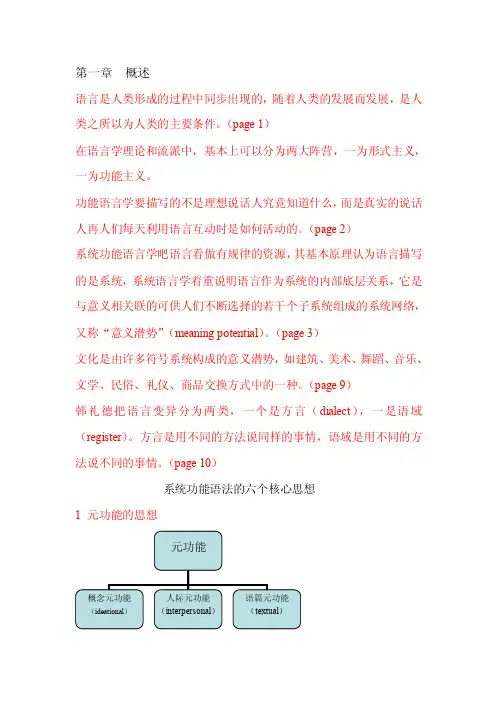
第一章概述语言是人类形成的过程中同步出现的,随着人类的发展而发展,是人类之所以为人类的主要条件。
(page 1)在语言学理论和流派中,基本上可以分为两大阵营,一为形式主义,一为功能主义。
功能语言学要描写的不是理想说话人究竟知道什么,而是真实的说话人再人们每天利用语言互动时是如何活动的。
(page 2)系统功能语言学吧语言看做有规律的资源,其基本原理认为语言描写的是系统,系统语言学着重说明语言作为系统的内部底层关系,它是与意义相关联的可供人们不断选择的若干个子系统组成的系统网络,又称“意义潜势”(meaning potential)。
(page 3)文化是由许多符号系统构成的意义潜势,如建筑、美术、舞蹈、音乐、文学、民俗、礼仪、商品交换方式中的一种。
(page 9)韩礼德把语言变异分为两类,一个是方言(dialect),一是语域(register)。
方言是用不同的方法说同样的事情,语域是用不同的方法说不同的事情。
(page 10)系统功能语法的六个核心思想1 元功能的思想2 系统的思想韩礼德的系统的思想是把语言系统解释成一种可以进行语义选择的网络,当有关系统的每个步骤一一实现后,便可产生结构。
这就是说系统理论是在使用中演变的,离开语言使用者的实践,它不会存在。
系统存在于所有语言层次,诸如语义层、词汇语法层和音系层,都各有自己的系统表示本层次的语义潜势。
(page 15)3 层次的思想语言是有层次的,至少包括语义层、词汇语法层和音系层。
各个层次之间存在着“体现”(realisation)的关系,即对“意义”的选择(语义层)体现于对“形式”(词汇语法层)的选择;对“形式”的选择又体现于对“实体”(音系层)的选择。
(page 16)4 功能的思想5 语境的思想6 近似的或盖然率的思想。
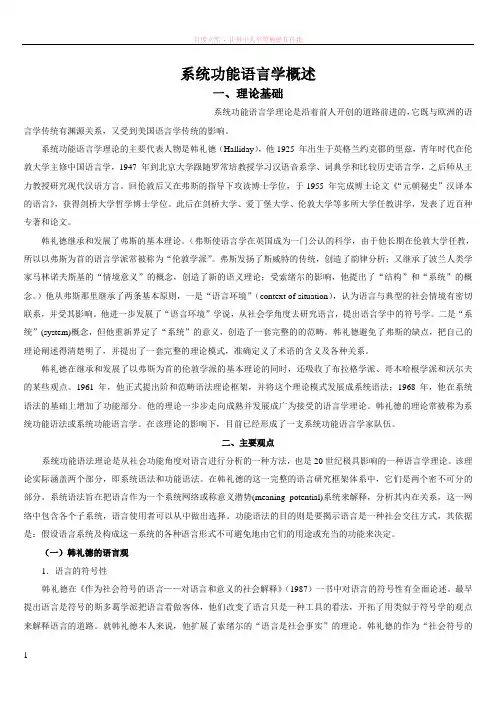
系统功能语言学概述一、理论基础系统功能语言学理论是沿着前人开创的道路前进的,它既与欧洲的语言学传统有渊源关系,又受到美国语言学传统的影响。
系统功能语言学理论的主要代表人物是韩礼德(Halliday),他1925 年出生于英格兰约克郡的里兹,青年时代在伦敦大学主修中国语言学,1947 年到北京大学跟随罗常培教授学习汉语音系学、词典学和比较历史语言学,之后师从王力教授研究现代汉语方言。
回伦敦后又在弗斯的指导下攻读博士学位,于1955 年完成博士论文《“元朝秘史”汉译本的语言》,获得剑桥大学哲学博士学位。
此后在剑桥大学、爱丁堡大学、伦敦大学等多所大学任教讲学,发表了近百种专著和论文。
韩礼德继承和发展了弗斯的基本理论。
(弗斯使语言学在英国成为一门公认的科学,由于他长期在伦敦大学任教,所以以弗斯为首的语言学派常被称为“伦敦学派”。
弗斯发扬了斯威特的传统,创造了韵律分析;又继承了波兰人类学家马林诺夫斯基的“情境意义”的概念,创造了新的语义理论;受索绪尔的影响,他提出了“结构”和“系统”的概念。
)他从弗斯那里继承了两条基本原则,一是“语言环境”(context of situation),认为语言与典型的社会情境有密切联系,并受其影响。
他进一步发展了“语言环境”学说,从社会学角度去研究语言,提出语言学中的符号学。
二是“系统”(system)概念,但他重新界定了“系统”的意义,创造了一套完整的的范畴。
韩礼德避免了弗斯的缺点,把自己的理论阐述得清楚明了,并提出了一套完整的理论模式,准确定义了术语的含义及各种关系。
韩礼德在继承和发展了以弗斯为首的伦敦学派的基本理论的同时,还吸收了布拉格学派、哥本哈根学派和沃尔夫的某些观点。
1961 年,他正式提出阶和范畴语法理论框架,并将这个理论模式发展成系统语法;1968 年,他在系统语法的基础上增加了功能部分。
他的理论一步步走向成熟并发展成广为接受的语言学理论。
韩礼德的理论常被称为系统功能语法或系统功能语言学。
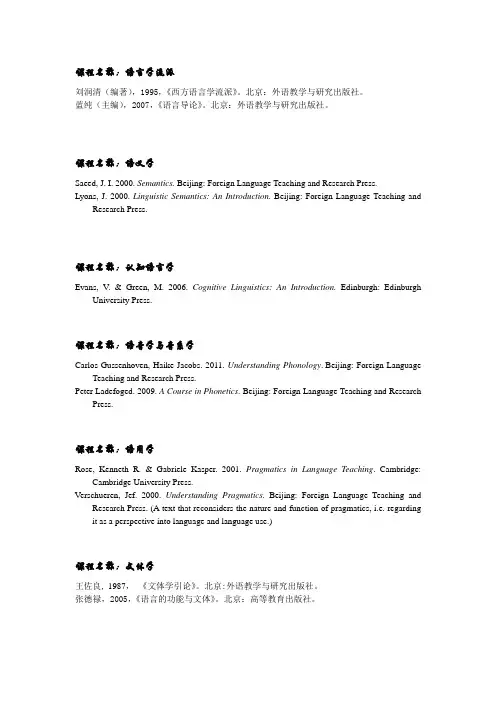
课程名称:语言学流派刘润清(编著),1995,《西方语言学流派》。
北京:外语教学与研究出版社。
蓝纯(主编),2007,《语言导论》。
北京:外语教学与研究出版社。
课程名称:语义学Saeed, J. I. 2000. Semantics. Beijing: Foreign Language Teaching and Research Press.Lyons, J. 2000. Linguistic Semantics: An Introduction. Beijing: Foreign Language Teaching and Research Press.课程名称:认知语言学Evans, V. & Green, M. 2006. Cognitive Linguistics: An Introduction.Edinburgh: Edinburgh University Press.课程名称:语音学与音系学Carlos Gussenhoven, Haike Jacobs. 2011. Understanding Phonology. Beijing: Foreign Language Teaching and Research Press.Peter Ladefoged. 2009. A Course in Phonetics. Beijing: Foreign Language Teaching and Research Press.课程名称:语用学Rose, Kenneth R. & Gabriele Kasper. 2001. Pragmatics in Language Teaching. Cambridge: Cambridge University Press.Verschueren, Jef. 2000. Understanding Pragmatics. Beijing: Foreign Language Teaching and Research Press. (A text that reconsiders the nature and function of pragmatics, i.e. regarding it as a perspective into language and language use.)课程名称:文体学王佐良,1987,《文体学引论》。
《系统功能语言学概论》评介《系统功能语言学概论》是功能语言学的入门读本,也是作功能语言学研究的核心和基础。
该书由胡壮麟、朱永生、张德禄和李战子编著,于20XX年由北京大学出版社出版。
本文将对该书主要内容进行简要介绍和评价,并对书中“评价理论与意识形态”一章进行详细解读。
1内容简介该书共分为13章。
第四、五、六章集中阐述了功能语法的三个元功能:概念功能,人际功能和语篇功能,这三章是该书的核心部分,概念功能包括经验功能和逻辑功能,经验功能指的是语言对人们在现实世界中各种经历的表达,逻辑功能指的则是语言对两个以上的意义单位之间逻辑关系的表达。
经验功能包括及物性和语态,六种及物过程和语态现也成为批评语篇分析的工具。
人际功能指讲话者通过语言表达他们的身份、地位、态度、动机和他们对事物的推断、判断和评价等功能,对语篇中人际功能的分析可以从语气结构和归一性与情态这两方面着手。
语篇功能是属于语义层的范畴,把语言成分组织成为语篇的功能叫语篇功能。
语篇功能可以通过主位结构,信息结构和衔接得到体现。
其中值得考察的是主位推进模式和有标记主位、无标记主位以及各种不同的衔接手段对于研究谋篇功能的意义。
第七、八章分别介绍了复句与词组,语域与语类。
第九章阐述了概念隐喻、人际隐喻和语篇隐喻。
概念隐喻主要是六大及物性过程的转换;人际隐喻包括情态隐喻和语气隐喻;至于语篇隐喻,韩礼德对它还持模糊的态度。
其中还涉及到隐喻性与一致性的运用的意义。
第十章“评价理论与意识形态”对于批评性话语分析有一定的借鉴作用,是本文要进行详细解读的部分。
该书的剩余部分分别讨论了系统功能语言学的应用、系统功能语法与其他语法流派的比较、功能语法内部的分歧和外界的质疑。
2启示与思考评价理论是由马丁等人提出,在系统功能语言学人际功能基础上发展而来的。
在实践应用研究方面包括话语分析的研究,對英语新闻语篇的研究和英语演讲语篇的研究等。
刘世铸(20XX)指出从评价理论视角分析新闻语篇与批评话语分析相得益彰,可以更好地揭示话语中的意识形态。
功能语言学部分主要参考文献功能语言学部分主要参考文献Halliday, M.A.K. 2000. An Introduction to Functional Grammar (2nd ed.). Beijing: Foreign Language Teaching and Research Press.Halliday, M.A.K. 2001. Language as Social Semiotic: the Social Interpretation of Language and Meaning. Beijing: Foreign Language Teaching and Research Press.Halliday, M.A.K., edited by Webster, J. 2007. On Grammar (Vol.1). Beijing: Peking University Press.Halliday, M.A.K., edited by Webster, J. 2007. Linguistic Studies of Text and Discourse (Vol.2).Beijing: Peking University Press.Halliday, M.A.K., edited by Webster, J. 2007. On Language and Linguistics (Vol.3). Beijing: Peking University Press.Halliday, M.A.K., edited by Webster, J. 2007. The Language of Early Childhood (Vol.4). Beijing: Peking University Press.Halliday, M.A.K., edited by Webster, J. 2007. The Language of Science (Vol.5). Beijing: Peking University Press.Halliday, M.A.K., edited by Webster, J. 2007. Computational and Quantitative Studies (Vol.6).Beijing: Peking University Press.Halliday, M.A.K., edited by Webster, J. 2007. Studies in English Language (Vol.7). Beijing: Peking University Press.Halliday, M.A.K., edited by Webster, J. 2007. Studies in Chinese Language (V ol.8). Beijing: Peking University Press.Halliday, M.A.K., edited by Webster, J. 2007. Language and Education (Vol.9). Beijing: Peking University Press.Halliday, M.A.K., edited by Webster, J. 2007. Language andSociety (Vol.10). Beijing: Peking University Press.Halliday, M.A.K. 2008. Complementarities in Language. Beijing: The Commercial Press. Halliday, M.A.K. and Hasan, R. 2001. Cohesion in English. Beijing: Foreign Language Teaching and Research Press.Halliday, M.A.K. and Matthiessen, C. M. I. M. 2004. An Introduction to Functional Grammar (3nd ed.). London: Arnold.Halliday, M.A.K., and Matthiessen, C.M.I.M. 1999. Construing Experience Through Meaning: A Language-based Approach to Cognition. London and New York: Continuum.Martin, J.R. 1992. English Text: system and structure. Amsterdam: John Benjamins.Martin, J.R. and White, P.R. 2008. The Language of Evaluation: Appraisal in English. Beijing: Foreign Language Teaching and Research Press.Martin, J.R., Matthiessen C.M.I.M., and Painter, C. 2010. Deploying Functional Grammar.Beijing: The Commercial Press.Matthiessen, C.M.I.M. and Halliday, M.A.K. 2009. Systemic functional grammar: a first step into the theory. Beijing: Higher Education Press.Thompson, G. 2008. Introducing Functional Grammar(2nd ed.). Beijing: Foreign Language Teaching and Research Press.曾蕾、廖海青,2010,《功能语言学与外语教学研究》。
系统功能语言学的著作
系统功能语言学的著作包括《系统功能语言学的社会语言学渊源》和《系统功能语言学概论》。
《系统功能语言学的社会语言学渊源》是胡壮麟的一本著作,介绍了系统功能语言学的起源和发展。
《系统功能语言学概论》是胡壮麟、朱永生、张德禄、李战子合著的一本著作,该书是“语言学与应用语言学知识读本”系列丛书之一,为语言学专业或对语言学感兴趣的大学高年级学生及研究生提供语言学及应用语言学各领域的基本知识介绍,对学生学好大学语言学课程和了解研究生语言学水平要求具有很大帮助。
如果想了解更多关于系统功能语言学的著作,可以咨询语言学专家或查阅相关文献资料,获取更详细和专业的信息。
应用语言学方向参考书目应用语言学方向参考书目1.Allright, D. & K. M. Bailey. 1991. Focus on the Language Classroom: An Introduction to ClassroomResearch for Language Teachers. Cambridge University Press. *2.Arnold, J. (ed.) 1999/2000. Affect in Language Learning. Cambridge University Press/外语教学与研究出版社/人民教育出版社。
*3.Bachman, Lyle. F. 1990. Fundamental Considerations in Language Testing. New Y ork: OxfordUniversity Press.4.Beckett, G. H. & P. C. Miller (eds.). 2006. Project-Based Second and Foreign Language Education:Past, Present and Future. Greenwich, CT: Information Age Publishing, Inc. *5.Brown, H. D. 1994/2001. Principles of Language Learning and Teaching(3rd edn). Pearson HallRegents/外语教学与研究出版社。
6.Brown, J. D. 1995/2001. The Elements of Language Curriculum: A Systematic Approach to ProgramDevelopment. Heinle & Heinle Publishers/外语教学与研究出版社。
系统功能语言学概论胡壮麟、朱永生、张德禄、李战子著北京大学出版社2005年9月第一版形式主义和功能主义(P2)形式语言学以“句法”代替”语法”,这反映了语言哲学中句法与语义学和语用学相对立的观点。
自古希腊以来,句法往往提示“语言被解释为一种形式系统,然后加上意义”。
形式语言学往往自称是最科学的,它研究理想的说话者,事实上,语言研究的一种观点并不是唯一的观点。
形式语言学成了对语言学的研究,而不是对语言的研究。
反之,在功能语言学中,语言被解释为意义系统,伴之以意义得以体现的形式。
形式是走向目的的手段,本身不是目的。
我们要问的不是“这些形式的意义是什么?”,而是“这些意义该如何表述?”. 功能语言学要描写的不是理想说话人究竟知道什么,而是真实的说话人在人们每天利用语言互动时是如何活动的。
系统语法与功能语法(p3)系统功能语言学包括“系统语法”和“功能语法”两个部分,但这不是两种语法的简单总和,而是一种完整的语法理论框架的两个不可分割的方面。
系统语法或系统语言学着重说明语言作为系统的内部底层关系,它是与意义相关联的可供人们不断选择的若干个子系统组成的系统网络(system network),又称“意义潜势”(meaning potential)。
语言作为符号的一种,在表述说话人想表达的语义时,必然要在语言的各个功能部分进行相应的选择。
在这种选择取决于使用语言时的语境的方方面面。
这种选择在语言的不同层次都可进行。
总之,内容决定形式,形式要由实体体现。
功能语法则说明语言是社会交往的工具。
语言系统的形成正是人们在长期交往中为了实现不同的语义功能决定的。
同样,当人们在语言系统中进行选择时,也是根据所要实现的功能而进行的有动因的活动。
韩礼德的语言史观(P6)韩礼德认为,当代语言学理论和流派的种种分歧,归根结底,有其历史根源。
这是因为在西方语言学史上早就形成了两种对立的观点,一种以普罗塔哥拉(Protagoras)和柏拉图为代表,一种以亚里士多德为代表。
第一章概述
语言是人类形成的过程中同步出现的,随着人类的发展而发展,是人类之所以为人类的主要条件。
(page 1)
在语言学理论和流派中,基本上可以分为两大阵营,一为形式主义,一为功能主义。
功能语言学要描写的不是理想说话人究竟知道什么,而是真实的说话人再人们每天利用语言互动时是如何活动的。
(page 2)
系统功能语言学吧语言看做有规律的资源,其基本原理认为语言描写的是系统,系统语言学着重说明语言作为系统的内部底层关系,它是与意义相关联的可供人们不断选择的若干个子系统组成的系统网络,又称“意义潜势”(meaning potential)。
(page 3)
文化是由许多符号系统构成的意义潜势,如建筑、美术、舞蹈、音乐、文学、民俗、礼仪、商品交换方式中的一种。
(page 9)
韩礼德把语言变异分为两类,一个是方言(dialect),一是语域(register)。
方言是用不同的方法说同样的事情,语域是用不同的方法说不同的事情。
(page 10)
系统功能语法的六个核心思想
1 元功能的思想
2 系统的思想
韩礼德的系统的思想是把语言系统解释成一种可以进行语义选择的网络,当有关系统的每个步骤一一实现后,便可产生结构。
这就是说系统理论是在使用中演变的,离开语言使用者的实践,它不会存在。
系统存在于所有语言层次,诸如语义层、词汇语法层和音系层,都各有自己的系统表示本层次的语义潜势。
(page 15)
3 层次的思想
语言是有层次的,至少包括语义层、词汇语法层和音系层。
各个层次之间存在着“体现”(realisation)的关系,即对“意义”的选择(语义层)体现于对“形式”(词汇语法层)的选择;对“形式”的选择又体现于对“实体”(音系层)的选择。
(page 16)
4 功能的思想
5 语境的思想
6 近似的或盖然率的思想。